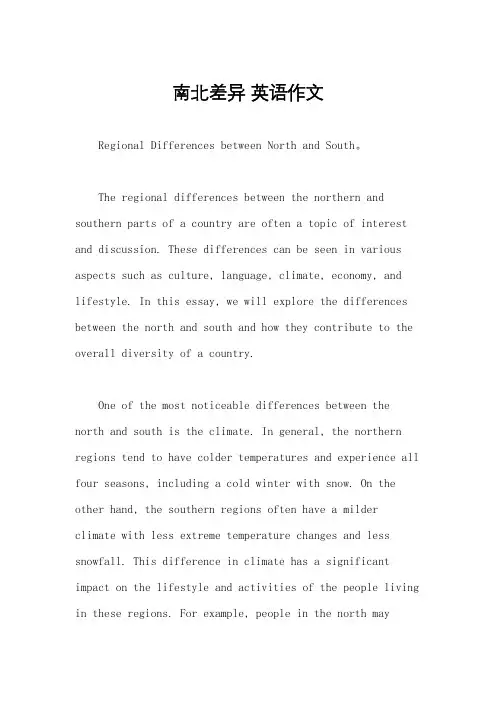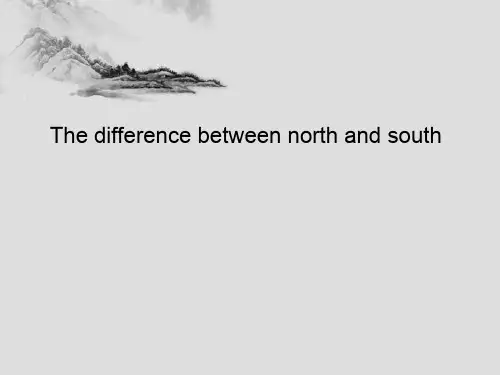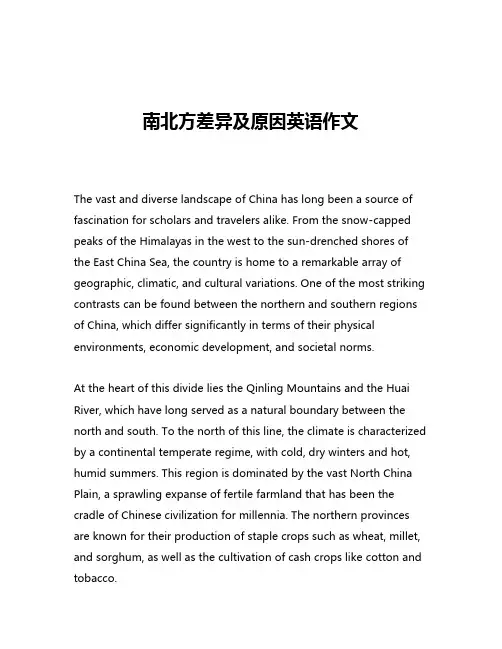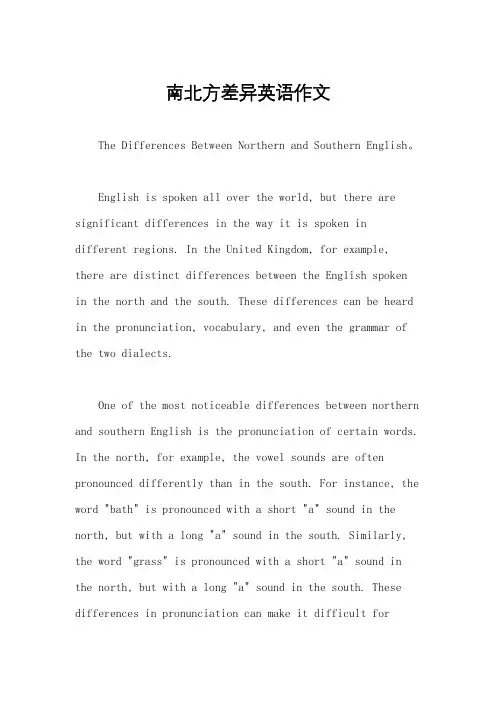南北方差异英文版 PPT
南北差异 英语作文

南北差异英语作文Regional Differences between North and South。
The regional differences between the northern and southern parts of a country are often a topic of interest and discussion. These differences can be seen in various aspects such as culture, language, climate, economy, and lifestyle. In this essay, we will explore the differences between the north and south and how they contribute to the overall diversity of a country.One of the most noticeable differences between the north and south is the climate. In general, the northern regions tend to have colder temperatures and experience all four seasons, including a cold winter with snow. On the other hand, the southern regions often have a milder climate with less extreme temperature changes and less snowfall. This difference in climate has a significant impact on the lifestyle and activities of the people living in these regions. For example, people in the north mayengage in winter sports such as skiing and snowboarding, while those in the south may enjoy outdoor activities year-round.Another aspect of regional differences is the cultural and linguistic diversity. The north and south may have distinct dialects or even different languages altogether. This linguistic diversity reflects the historical and cultural differences between the two regions. Additionally, the food, traditions, and customs may vary greatly between the north and south, adding to the richness of thecountry's cultural tapestry.Economically, the north and south may have different industries and sources of income. For example, the north may be more industrialized, with a focus on manufacturing and technology, while the south may rely more onagriculture and tourism. These economic differences can lead to variations in the standard of living, job opportunities, and overall economic development between the two regions.Furthermore, the north and south may have different political and social landscapes. Historical events and geopolitical factors may have shaped the attitudes and beliefs of the people in each region, leading to distinct political ideologies and social norms. These differences can be seen in voting patterns, social movements, and even the overall mindset of the people.Despite these differences, it is important to recognize that the north and south complement each other and contribute to the overall diversity and richness of a country. The unique characteristics of each region add depth and complexity to the national identity, creating a vibrant tapestry of cultures, traditions, and perspectives.In conclusion, the regional differences between the north and south are a fascinating aspect of any country. These differences can be seen in various aspects such as climate, culture, economy, and politics. While these disparities may sometimes lead to misunderstandings or conflicts, they ultimately contribute to the diversity and richness of a nation. Embracing and celebrating thesedifferences can lead to a greater understanding and appreciation of the various regions within a country.。
南北方差异 英语

Phoenix
Zhangjiajie
张家界
The famous movie Avatar took views in Zhangjiajie
the leaves have all come off, leaving the trees bare and no life.
The weather
2012.9.
The scenery
• No trees • No grass • Dry • Wingy
But there are a lot of beautiful sceneries in the north,too
This is Yesanpo in Baoding, Hebei
The sceneries in the South ,beautiful
rainy season
Thanks to the rainy weather, the sceneries here are very beautiful and the people here have good skin.
In north, the staple food is pasta
This girl is from the Northeast , I am very afraid to drink with her.
in the soutew of beer.
Question
• Dear classmates,the south and the north , which do you prefer ?
deeply. Every time I take the bus out, I am able to hear a variety of accents。
南北差异 英语作文

南北差异英语作文The Differences between North and South。
China is a vast country with a long history and diverse cultures. It is divided into two major regions, the North and the South, which have distinct differences in geography, climate, economy, and culture.Firstly, the North is characterized by its vast plains, deserts, and plateaus, while the South is known for its mountains, hills, and rivers. The North has a harsherclimate with cold winters and hot summers, while the South has a warm and humid climate with mild winters and hot summers.Secondly, the North is more industrialized and developed, with cities like Beijing, Tianjin, and Shanghai being the economic and political centers of the country.The South, on the other hand, is more agricultural and rural, with cities like Guangzhou, Shenzhen, and Hong Kongbeing the commercial and financial centers of the region.Thirdly, the North has a more traditional and conservative culture, with a strong emphasis on Confucianism and family values. The South, on the other hand, has a more open and liberal culture, with a strong influence from Buddhism and Taoism.Lastly, the North and South have different cuisines, with the North being known for its wheat-based dishes like dumplings and noodles, while the South is famous for its rice-based dishes like congee and stir-fried rice.Despite these differences, both regions have contributed greatly to the development of China and have their unique charms and attractions. The Great Wall and the Forbidden City in the North, and the West Lake and the Yellow Mountains in the South are just a few examples of the many cultural and natural wonders that can be found in China.In conclusion, the differences between the North andSouth of China are significant and reflect the country's diversity and complexity. However, they also represent the unity and harmony that exist within the Chinese culture and people.。
南北方差异及原因英语作文

南北方差异及原因英语作文The vast and diverse landscape of China has long been a source of fascination for scholars and travelers alike. From the snow-capped peaks of the Himalayas in the west to the sun-drenched shores of the East China Sea, the country is home to a remarkable array of geographic, climatic, and cultural variations. One of the most striking contrasts can be found between the northern and southern regions of China, which differ significantly in terms of their physical environments, economic development, and societal norms.At the heart of this divide lies the Qinling Mountains and the Huai River, which have long served as a natural boundary between the north and south. To the north of this line, the climate is characterized by a continental temperate regime, with cold, dry winters and hot, humid summers. This region is dominated by the vast North China Plain, a sprawling expanse of fertile farmland that has been the cradle of Chinese civilization for millennia. The northern provinces are known for their production of staple crops such as wheat, millet, and sorghum, as well as the cultivation of cash crops like cotton and tobacco.In contrast, the southern regions of China enjoy a subtropical climate, with milder winters and longer growing seasons. This has allowed for the development of a more diverse agricultural economy, with a greater emphasis on rice cultivation, as well as the production of cash crops like tea, silk, and sugarcane. The rugged terrain of the south, with its mountainous landscapes and winding river systems, has also fostered the growth of a vibrant commercial and trading network, connecting the interior regions to the bustling coastal cities.These environmental differences have had profound implications for the economic and social development of the north and south. The North China Plain, with its vast expanses of arable land and relatively stable climate, has historically been the center of political power and economic might in China. The imperial capitals of ancient dynasties, such as Beijing and Xi'an, were located in the north, and the region has long been the heartland of Chinese civilization.The southern provinces, on the other hand, have often been viewed as more peripheral and less developed, at least from the perspective of the northern elite. However, this perception belies the dynamism and innovation that have characterized the south throughout China's history. The coastal regions, in particular, have been hubs of trade, commerce, and cultural exchange, with vibrant cities like Guangzhou, Xiamen, and Shanghai serving as gateways to the wider world.Moreover, the rugged terrain and more diverse climate of the south have fostered the development of distinct cultural traditions and social structures. The southern provinces are known for their strong regional identities, with local dialects, cuisine, and customs that often differ significantly from those of the north. This sense of regional pride and autonomy has, at times, created tensions with the central government, which has sought to maintain a unified national identity.One of the most striking differences between the north and south can be seen in the realm of education and intellectual life. The northern provinces have long been the center of Confucian learning and the imperial examination system, which emphasized the mastery of classical texts and the cultivation of a scholar-gentry class. This has led to a strong emphasis on rote learning and the preservationof traditional knowledge, with less emphasis on innovation and creative thinking.In contrast, the southern provinces have often been more open to new ideas and influences from abroad. The coastal cities, in particular, have been hubs of international trade and cultural exchange, exposing the local population to a wider range of intellectual and artistic traditions. This has fostered a more dynamic and innovative intellectual culture, with a greater emphasis on practical knowledge and the application of scientific and technological advances.These differences in economic, social, and intellectual development have also had implications for the political and social dynamics within China. The northern provinces have traditionally been the stronghold of the central government, with a more centralized and hierarchical power structure. In contrast, the southern provinces have often been more resistant to central control, with a stronger tradition of local autonomy and regional identity.This tension between the north and south has played out in various ways throughout China's history, from the political rivalries of ancient dynasties to the ideological conflicts of the modern era. The Communist revolution, for example, was largely driven by the rural peasantry of the south, who were often marginalized by the northern-dominated Nationalist government.Today, the divide between the north and south continues to shape the social, economic, and political landscape of China. The rapid industrialization and urbanization of the coastal regions, for instance, have led to the emergence of a new class of wealthy entrepreneurs and tech innovators, many of whom hail from the southern provinces. At the same time, the northern provinces have struggled to keep pace with the economic dynamism of the south, leading to growing regional disparities and social tensions.Despite these challenges, the coexistence of the north and south has been a source of strength and resilience for China. The diversity of the country's geographic, cultural, and intellectual traditions has enabled it to adapt to changing circumstances and to draw upon a rich reservoir of human and natural resources. As China continues to evolve and transform in the 21st century, the interplay between the north and south will undoubtedly continue to shape its trajectory and its place in the global community.。
南北方差异及原因英语作文

南北方差异及原因英语作文The differences between the north and the south of China are quite distinct in terms of culture, climate, food, and lifestyle.Firstly, one of the most obvious differences is the climate. The north of China has a continental climate, with hot summers and cold winters, while the south has a subtropical climate, with milder winters and hot and humid summers. This difference in climate has a huge impact on the types of crops that can be grown and the types of activities that people engage in.Secondly, there are significant differences in food and cuisine. Northern cuisine is known for its wheat-based dishes, such as dumplings, noodles, and steamed buns, while southern cuisine is famous for its rice-based dishes, such as rice noodles, rice cakes, and rice porridge. The use of different ingredients and cooking methods also contribute to the distinct flavors of northern and southern dishes.Furthermore, the cultural differences between the north and the south are also quite prominent. The north has along history of imperial rule and is known for its traditional architecture, such as the Forbidden City in Beijing and the Great Wall of China. In contrast, the south has a rich maritime history and is known for its beautiful water towns, such as Suzhou and Hangzhou.The lifestyle of people in the north and the south also differs. Due to the harsher climate in the north, people tend to live a more indoor-oriented lifestyle, while in the south, people are more likely to engage in outdooractivities due to the milder climate.The reasons for these differences can be attributed to the geographical and historical factors. The north of China is located in the temperate zone, while the south is in the subtropical zone, resulting in different climates and agricultural practices. Additionally, the historical influences of different dynasties and empires have shaped the culture, architecture, and cuisine of each region.中文:中国南北方的差异在文化、气候、食物和生活方式方面都是十分明显的。
南北方差异英语作文

南北方差异英语作文The Differences Between Northern and Southern English。
English is spoken all over the world, but there are significant differences in the way it is spoken indifferent regions. In the United Kingdom, for example, there are distinct differences between the English spokenin the north and the south. These differences can be heard in the pronunciation, vocabulary, and even the grammar of the two dialects.One of the most noticeable differences between northern and southern English is the pronunciation of certain words. In the north, for example, the vowel sounds are often pronounced differently than in the south. For instance, the word "bath" is pronounced with a short "a" sound in the north, but with a long "a" sound in the south. Similarly, the word "grass" is pronounced with a short "a" sound in the north, but with a long "a" sound in the south. These differences in pronunciation can make it difficult fornortherners and southerners to understand each other at times.Another difference between northern and southern English is the vocabulary that is used. There are many words that are used in the north that are not used in the south, and vice versa. For example, in the north, people might say "ginnel" to refer to a narrow passageway, while in the south, people might say "alleyway." Similarly, in the north, people might say "mash" to refer to mashed potatoes, while in the south, people might say "mashed potato." These differences in vocabulary can lead to confusion and misunderstandings between northerners and southerners.Finally, there are also differences in the grammar of northern and southern English. For example, in the north, people might say "I were" instead of "I was," while in the south, people might say "I was." Similarly, in the north, people might say "I done it" instead of "I did it," while in the south, people might say "I did it." These differences in grammar can make it difficult fornortherners and southerners to communicate effectively with each other.In conclusion, there are significant differences between northern and southern English in terms of pronunciation, vocabulary, and grammar. These differences can make it difficult for northerners and southerners to understand each other at times, and can lead to confusion and misunderstandings. However, these differences also add to the richness and diversity of the English language, and should be celebrated as such.。
中国南北方的差异英语作文七年级
中国南北方的差异英语作文七年级"The Differences between North and South in China"China is a vast country with remarkable differences between the north and the south.The climate in the north is relatively dry and cold, while the south is generally warmer and more humid. This leads to different landscapes. In the north, there are vast plains and deserts, while the south has lush forests and beautiful rivers. The food culture also varies. In the north, people like to eat noodles, steamed buns and other staple foods. In the south, rice is the main food, and there are many delicious dishes like sweet and sour pork.The dialects are different. The northern dialect is relatively straightforward, while the southern dialects are more diverse and complex.Even the personalities of people in the north and south show some differences. People in the north are often considered more forthright and bold, while those in the south are thought to be more delicate and gentle.In general, these differences make China a rich and colorful country.译文:“中国南北方的差异”中国是一个幅员辽阔的国家,南北方有着显著的差异。
南北方差异的英语作文
南北方差异的英语作文The differences between the north and the south are quite striking. For example, the weather in the north can be very cold and dry, while in the south it is often warm and humid. This can have a big impact on people'slifestyles and daily routines.In terms of food, there are also significant differences between the north and the south. Northern cuisine tends to be more hearty and meat-based, while southern cuisine is often lighter and focuses more on vegetables and seafood. This reflects the different climates and agricultural practices in the two regions.Another noticeable difference is the way people communicate. In the north, people may be more direct and to the point, while in the south, there is often more emphasis on politeness and indirect communication. This can lead to misunderstandings and cultural clashes between people from different regions.The architecture and city layout also vary greatly between the north and the south. In the north, you may find more traditional, older buildings and narrow, winding streets. In the south, cities are often more modern and planned, with wider roads and newer buildings. Thisreflects the different historical and economic development of the two regions.Overall, the differences between the north and the south are not just limited to one aspect of life, but permeate every aspect of culture and society. It's these differences that make China such a diverse and fascinating country.。
南北方差异英语作文
南北方差异英语作文The Differences Between Northern and Southern English。
The English language is spoken in various accents and dialects around the world. In particular, the differences between Northern and Southern English are quite distinct. These differences can be observed in pronunciation, vocabulary, and grammar, and they reflect the unique cultural and historical backgrounds of each region.One of the most noticeable differences between Northern and Southern English is the pronunciation of certain words. For example, the Northern accent tends to be more rounded and nasal, while the Southern accent is often more clipped and precise. This can be seen in the pronunciation of words such as "bath" and "grass," which are pronounced with a short "a" sound in the South and a longer "a" sound in the North. Additionally, the Northern accent often includes the use of diphthongs, while the Southern accent tends to have more monophthongs.In terms of vocabulary, there are also significant differences between Northern and Southern English. For example, in the North, people may use words like "ginnel" for a narrow alleyway, "mardy" for being moody or sulky, and "brew" for a cup of tea. In the South, on the other hand, people may use words like "alley" for the same narrow walkway, "grumpy" for being moody, and "cuppa" for a cup of tea. These regional differences in vocabulary reflect the unique cultural and historical influences on the English language.Another key difference between Northern and Southern English is the grammar and syntax used in each region. In the North, people may use grammatical constructions such as "I were" instead of "I was" and "she were" instead of "she was." In the South, on the other hand, people are more likely to use standard English grammar and syntax. These differences in grammar and syntax reflect the historical development of the English language in each region.The differences between Northern and Southern Englishare not just linguistic, but also cultural and historical. The Northern accent and vocabulary can be traced back tothe Viking and Scandinavian influences on the region, while the Southern accent and vocabulary can be traced back tothe influence of the Normans and the French language. These historical influences have shaped the English language in each region and continue to be reflected in the linguistic differences between the North and the South.In conclusion, the differences between Northern and Southern English are significant and reflect the unique cultural and historical backgrounds of each region. These differences can be observed in pronunciation, vocabulary, and grammar, and they contribute to the rich diversity ofthe English language. By understanding and appreciating these differences, we can gain a deeper insight into the linguistic and cultural heritage of the North and the South.。
完整版The diet of the North and the South in China英文版 中国南北方饮食文化差异.ppt
优选
2
I.Introduction
The northerners like pasta and southerners like
rice. Northerners like stew, but southerners like
delicate dishes. Soup is served as a dish in south,
especially drinking more soup in the hot summer
weather and generally before meals. In north
soup is generally not served as a dish, only after
meals. Southerners like to eat onions, but the
The diet of the North and the South in China
优选
1
Abstract
Referring to the differences of the north and south, we will first think of that the southern staple food is rice and northern food is flour. The staple food’s differences cause the entire diet and eating differences. Now, I will introduce the diet differences between the north and south. I think knowing the reasons of those differences is very important. Because different diet shows different culture. There are some students coming from south and some coming from north. In order to get along well with each other, I think learning the diet culture’s differences can be a good idea.
- 1、下载文档前请自行甄别文档内容的完整性,平台不提供额外的编辑、内容补充、找答案等附加服务。
- 2、"仅部分预览"的文档,不可在线预览部分如存在完整性等问题,可反馈申请退款(可完整预览的文档不适用该条件!)。
- 3、如文档侵犯您的权益,请联系客服反馈,我们会尽快为您处理(人工客服工作时间:9:00-18:30)。
Body type
The reason of the differences in height and weight is the impact of the environment and food.
In general, people living in prairies(大草原) or in high latitude(高纬度)and eating wheat flour(小麦粉) are very burly(高大魁梧). People who lived in plain areas(平原地区) and engaged in farming are always with short height.
Diet
Language
Southern language is complex, northern language is relatively uniform(统一). There are some communication barriers between norteatutiful scenary of Heilongjiang part
TRAVEL NOTES
TRAVEL NOTES
The traditional and delicious food of Heilongjiang
02
part
Differences between North and South
CONTENTS
Height Body type
Diet Language
Height
The average height of males in north China is 1.693 meters, while that in south is 1.647 meters.
The food cultures of is that people in south are based on eating rice but in north, they prefer eating noodles . However , the rice in Northeast is famous.
The life habits in north and south are different too. Exquisite(细腻的) southern and straightforward(坦率)
northern have been vivid contrasts .
Therefore, southern speak euphemistically(委婉地), northern speak bluntly(直率地).
